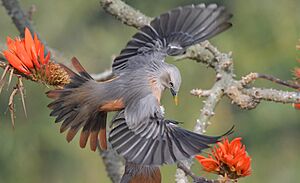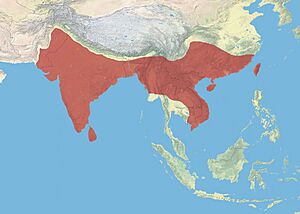Chestnut-tailed starling facts for kids
Quick facts for kids Chestnut-tailed starling |
|
|---|---|
 |
|
| Chestnut-tailed starling in Satchari National Park | |
| Conservation status | |
| Scientific classification | |
| Genus: |
Sturnia
|
| Species: |
malabarica
|
 |
|
| approximate range | |
| Synonyms | |
|
Temenuchus malabaricus |
|
The chestnut-tailed starling (Sturnia malabarica) is a cool bird from the starling family. You might also hear it called the grey-headed starling or grey-headed myna. These birds live in India and Southeast Asia, often in forests. Some stay in one place, while others travel a bit. The name "Malabarica" comes from a region in India called Malabar, where a type of this bird used to live. There's a close relative, the Malabar starling, which has a white head and is now considered a different species.
About Its Name
The chestnut-tailed starling got its official name in 1789 from a German scientist named Johann Friedrich Gmelin. He first put it in the same group as thrushes. He based his description on notes from another French scientist, Pierre Sonnerat, who had seen the bird in India.
For a long time, this starling was part of a group called Sturnus. But scientists later used new methods, like studying bird DNA, and found that this group was too mixed up. So, the chestnut-tailed starling and a few other starlings were moved to a different, older group called Sturnia. This group was first named in 1837 by René Lesson.
There are two main types, or subspecies, of the chestnut-tailed starling:
- S. m. malabarica: This type is found in most of India (but not the southwest or far northeast), southern Nepal, and Bangladesh.
- S. m. nemoricola: This type lives in southern Assam (northeast India), Myanmar, and parts of northern and central Indochina.
Both types of chestnut-tailed starlings are known to move around. For example, S. m. malabarica has been seen in Pakistan and central and southern India.
There's another bird, the Malabar starling (Sturnia blythii), which used to be thought of as a type of chestnut-tailed starling. But now, most scientists agree it's its own separate species. The chestnut-tailed starling only visits the Malabar starling's home during winter. Because they don't live together during breeding season, they don't interbreed (have babies together).
What It Looks Like
Adult chestnut-tailed starlings are about 20 cm (7.9 in) long. They have grey feathers on their upper body and blackish wing feathers. The color of their belly and tail depends on which type of starling it is.
In the main type (malabarica) and the Malabar starling (blythii), their belly and under-tail feathers are a reddish-brown color. But in the nemoricola type, these feathers are more whitish with a reddish tint, especially on their sides.
Both malabarica and nemoricola types have a light grey head with some whitish streaks, especially on the top of their head and around their neck. All of them have white eyes and a yellow beak with a pale blue base. Male and female starlings look very similar. Young starlings have whitish bellies and only reddish-brown tips on their tail feathers.
How It Behaves
Chestnut-tailed starlings usually build their nests in open woodlands or farmed areas. They like to use old holes in tree trunks that were made by birds like barbets or woodpeckers. These nests are often 3–12 m (9.8–39.4 ft) high up in the tree.
A female starling usually lays 3 to 5 eggs. These eggs are pale blue and don't have any spots. The nesting season for these birds is usually from March to June.
Like most starlings, these birds eat many different things. They are omnivorous, which means they eat both plants and animals. Their diet includes fruits, nectar from flowers, and insects. You can often see them flying in large, tight groups. They can change direction very quickly and all at once, which looks amazing!


